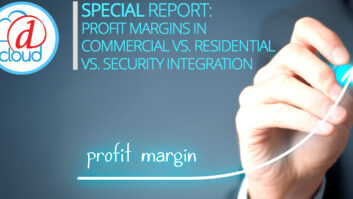[EDITOR’S NOTE: VITAL is in its second year of monthly CI Business Mastery Classes where it addresses important CI business topics via webinars. Each class is supported by an industry brand. VITAL has agreed to share some of the information from these classes in a monthly column of highlights from its most recent webinar. The topics are the same as the previous year’s classes, but the content is refreshed. This CI Business Mastery Class was on profit levers, and it was supported by AudioControl.]

Last month, we briefly talked about the levers for profit margin. We’re going to dive a bit more into those today and discuss the profit levers that are available to integrators and which matter most.
The three most important outcomes of a custom integration company — and any business — are revenue growth, net operating profit, and cash. These outcomes are driven by which levers we pull — which actions we take — to deliver the biggest results. As integrators, we have many different levers, but how do we really know which levers to pull to get the most out of our profit performance?
Here are the profit levers available to you:
- Mix: The mix of what you sell. At VITAL, we break this down simply into equipment, parts, and labor. Although there are advantages to tracking this more deeply, getting the big numbers right is always the best first step.
- Margin: Equipment, parts, and labor generate different margins, and, of those, equipment is the most stable and predictable.
- Compensation: Payments to staff.
- Productivity: How productive the people are that you employ. Productivity and compensation are tied together.
- Expenses: The costs your company incurs to keep the doors open.
- Working Capital: The cash side of the business, also known as accounts receivable and inventory. How much of that do you carry?
- Fixed Assets: Includes your vehicles, building, showrooms, tools, and so on. These are all the fixed assets that you deploy in your business to help generate cash and income.
How you leverage those last two is massively important for managing the cash flow in your business, and we will cover cash flow in a future column.
Gross margin is the number one profit lever in the business, hands down. It is the currency that allows you to cover expenses and make that net operating profit. It is how you pay the bills. It is how you pay your non-billable people and your billable staff. It’s how you take care of business.
Achieving a predictable gross margin requires intentional bid practices. The gross margin on your equipment is well-defined. Parts can be a little bit more nebulous. When was the last time you compared how much you pay for a roll of blue tape or booties and things of that nature? Those things experience frequent price changes that you’re not aware of, often purchased in bulk, and rarely tracked accurately at the project level.
Of course, the big variable in our proposals is labor. The number of hours a project will take is an educated guess at best. Even worse, you don’t know if those are going to be overtime hours or regular hours. You don’t know if that’s going to be your highest-paid staff or your least-paid staff. There are many variables on the labor side.
This is where the Revenue Mix profit lever comes into play. A very common mix recommendation from the VITAL method is 55 percent equipment, 35 percent labor, and 10 percent parts. This is a good starting place across the country for many integrators who are not quite hitting the mark. We should make greater margins on parts and labor, while equipment margins are limited by several other factors.
The Rule of 49 can help you put your bids together and allow you to get much closer to the mix and margin that you need. As you’re creating a proposal, put in all the equipment and parts and then multiply that number by 49 percent, or 0.49. That’s going to get you close to your baseline labor revenue target.
We’re talking about average jobs here. We’re not talking about that service job where you’re replacing a $60,000 projector with a $100,000 projector and it’s going to take 10 hours of labor. Obviously, that doesn’t fit. But for your average-size job, this should work. For many of you, that’s going to be a big jump in your normal labor and that’s okay. You don’t have to start there right out of the gate, but the Rule of 49 will help get you closer to where you want to go.
Productivity is where your target blended margin meets reality. The single most common reason for underwhelming profits is the labor margin squeeze that happens when the proposal meets reality. Productivity is the measure of revenue or margin that a technician can generate.
Your hourly bill rate should be set at four to five times the average hourly tech pay in your business. Forget about overtime for now — just use their regular hourly rate. If it’s $30/hour, your project bill rate should be $120 to 150/hour. This number works every time because this gives you enough coverage for the burdened rate and, more importantly, enough coverage against productivity. Remember, it truly does not matter what anyone else charges for their labor, even in your market, but especially in other markets. Your labor is the unique value your company adds to the commodities you sell, and it needs to be priced with enough margin for you to succeed as a business.
Compensation is the number one expense in your business. If you can keep your overall compensation below 35 percent of revenue, which means for every $100 you collect from your customers, you spend about $35 or less on your team, you’re in good shape. The makeup of that compensation expense is also very crucial, as the amount of revenue and gross margin you can produce is a function of the type of staff you have in place.
Indirect pay, commonly called unbillable staff, contributes a ton of weight to the profit success in your business. The key thing here is to aim for 50 percent or less of your payroll going to non-billable staff, including the owner. Any time you reach more than 50 percent of your compensation going to unbillable staff, it’s time to start paying attention because that billable staff — the technicians and field staff — are the ones who are bringing in the gross margin every day.
For more information about the CI Business Mastery Classes and the other services VITAL provides, visit http://growwithVITAL.com.





